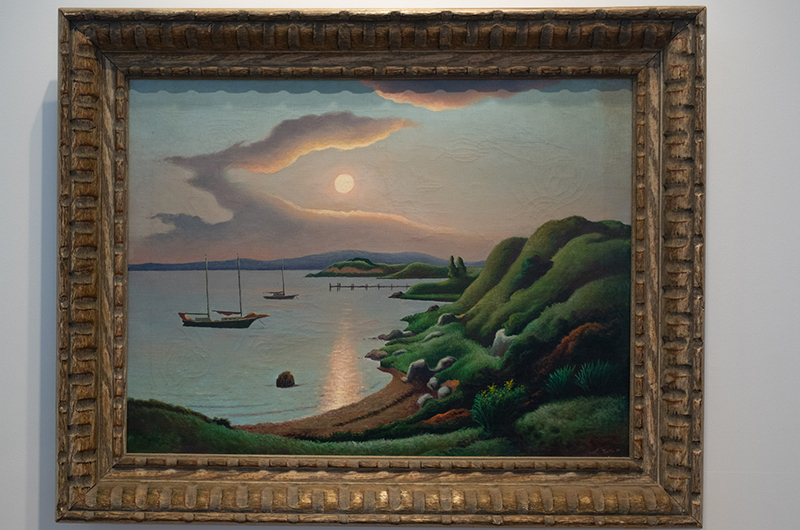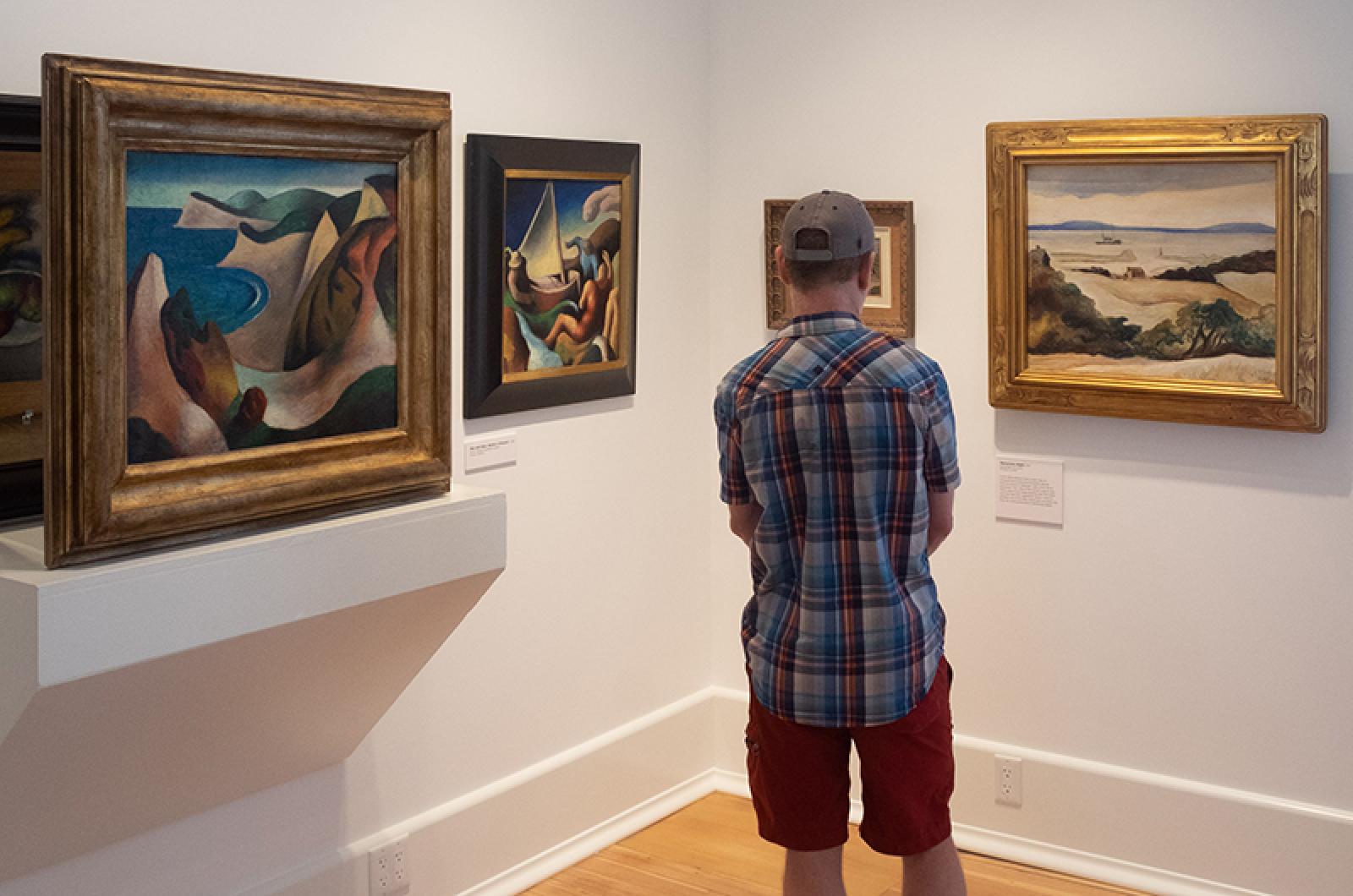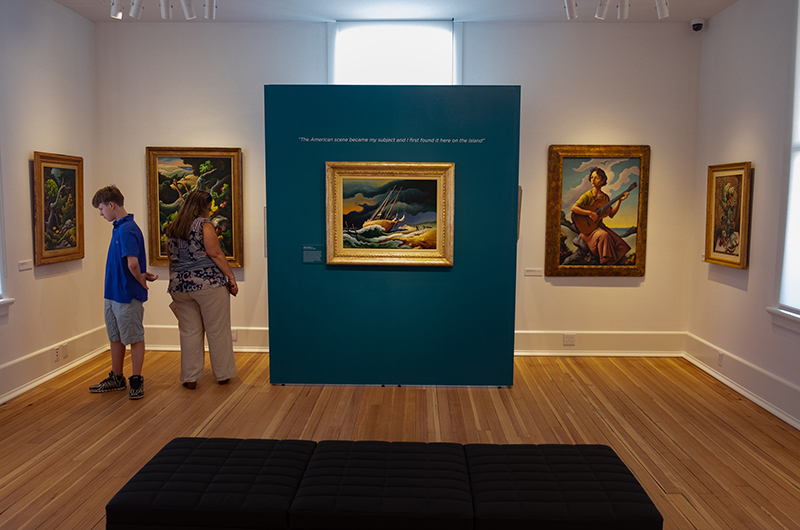The world knows Thomas Hart Benton as one of the most iconic painters of 20th-century America, his work as recognizable as that of Grant Wood or Edward Hopper.
On Martha’s Vineyard, Benton is also remembered as a lifelong summer resident who chronicled Island people and scenes for more than 50 seasons here, beginning in 1920.
From his Modernist early work to the more realistic views he captured in the 1960s, Martha’s Vineyard was a touchstone for the Midwestern native, who called it “the only place I ever found peace.” Although he is best known for his narrative paintings and murals off-Island, for years Benton painted many of his major works on the Vineyard.

The exhibit Benton’s Martha’s Vineyard, at the Martha’s Vineyard Museum through August 11, reveals both sides of the artist’s legacy — the Island storyteller and the household-name painter — with an exhibition that, in a better world, would travel on to major art museums across the country.
The paintings, sketches, drawings, prints and ceramics on display, some rarely seen in public, span most of Benton’s Vineyard years, providing a special lens through which to view his development as an artist.
The show’s earliest work, the oil South Beach, Martha’s Vineyard, dates from 1920, Benton’s first summer here, when he was in his early 30s and so strapped for materials that he painted it on the back of an older still life.
Following the example of the New Britain Museum of American Art, which loaned this painting and several others in the show, the Martha’s Vineyard Museum has hung the canvas away from the wall with a mirror rigged behind it so viewers can see, upside down on the back, Benton’s 1917 Still Life with Fruit.
Another piece from 1920-21, Men with Boat, Martha’s Vineyard, is one of several works loaned to the show by private collectors, both named and anonymous. Some are dramatic. Study for the Flight of the Thielens, circa 1938, arose from the true story of an Island family caught in the devastating September hurricane of that year, while After the Storm (1952) depicts the rescue of sailors from a grounded sailing ship.
Other glimpses into the Vineyard of the past include Farming Near Menemsha (1924-26), a view of Menemsha Bight from 1927, Woodcutters at Chilmark (1948) and the expansive View from Our Hill, Chilmark, dated after 1941.
Many of the loaned works appear in the show through the courtesy of the artist’s daughter, Jessie Benton. They include Vineyard scenes and people as well as colorful paintings from a series he created for the nature-loving girl’s birthdays: The Butterfly Chaser (1951) and Three Brothers, a woodland view from 1957.
Ms. Benton also loaned the show’s youngest work, 1969’s Sunrise at Menemsha Pond, and some of her father’s undated ceramics, including a bowl with swimmers reminiscent of the sailors in Men with Boat and a series of glazed earthenware tiles with nudes.
West Tisbury’s Granary Gallery contributed numerous pieces to the show, including the Surrealist mid-1920s oil Sea Phantasy and a still life, with identifiably Island-grown flowers and ferns, from the mid-1940s.
In a video alcove furnished with a bench for comfortable viewing, museum visitors can watch Benton at work painting Vineyard schooner captain Zeb Tilton, in a restored film clip from a 1941 fundraiser for the Martha’s Vineyard Hospital.
Benton in motion is exactly the man captured in still photographs and portraits by his contemporaries: fiercely mustached and deeply intent on his subject.
His completed portrait of Capt. Tilton — bequeathed by the artist to the museum when it was still the Dukes County Historical Society in Edgartown — hangs near the video screen in the darkened alcove.
The painter’s influence on American art is indicated in two Island views by his protégé Jackson Pollock, a frequent Vineyard houseguest of the Benton family in the 1930s. These images from his early 20s — a Menemsha oil on canvas and an untitled oil on board — offer a rare look at Pollock’s work before he emerged as a dominant Abstract Expressionist.
Benton artifacts are also on display in the show: paints, brushes, snapshots, his fedora and the harmonica he loved to play in home music sessions, as well as portraits of the artist and his family by photographer Alfred Eisenstaedt — who himself appears in a Benton sketch from 1945.
Benton’s Martha’s Vineyard is accompanied by a 40-page color catalog. The exhibition is on display Tuesdays through Sundays until August 11, with daily tours at 11 a.m. and 2 p.m. and a 5 p.m. tour on Tuesdays, when museum admission is free from 5 to 8 p.m. For more information, visit mvmuseum.org.








Comments
Comment policy »